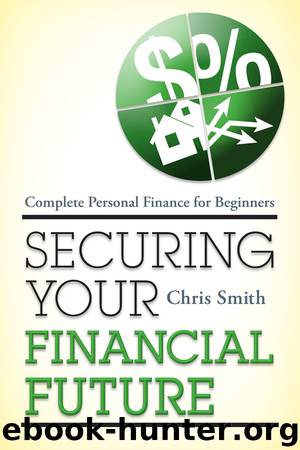Securing Your Financial Future by Chris Smith

Author:Chris Smith [Smith, Chris]
Language: eng
Format: epub
Publisher: Rowman & Littlefield Publishers
Published: 2012-06-13T16:00:00+00:00
Figure 12.1. House affordability table.
To determine the highest house price you are likely to comfortably qualify for, multiply your annual income by the appropriate multiple on the table. So if you make $50,000 per year and the rates for 30-year fixed-rate mortgages with 20% down are running at 7%, then the maximum house price that you should be looking at is $150,000. If you earlier determined that your bare-minimum acceptable houses cost more than that, you’ll need to continue renting and work to improve your income. But if houses are available for less than that, you can proceed. In other words, if the maximum affordable house (from the table) is greater than the minimum acceptable houses (from your research), you pass.
This can get tricky if you have supplemental income in addition to your primary job (which I hope you do). The rule of thumb is that if the supplemental income is regular, predictable, and well documented, you’ll probably be able to include it; otherwise, probably not. If this is your situation, and this is what makes the difference between passing this test or not, you should seek clarification from a lending professional before proceeding.
5. The Cash-Bucket Test
“Is my cash bucket full?”
This is the simplest test of all to understand, but that doesn’t make it easy! As a reminder, full means either 4, 6, or 8 months’ average primary income, depending on the degree of risk you’re facing, as described in chapter 8.
If your cash bucket is full, you pass. Just remember that house buying is not a financial emergency, so you won’t be using anything from your cash bucket throughout the entire buying process. If it isn’t yet full, continue saving until it is.
6. The 27% Test
“Have I saved up enough for down payment, closing costs, and move-in costs?”
Here is another simple test, but brace yourself: for most people, it is the toughest one to pass and the one that will almost certainly take you the most time. Here it is, plain and simple: you will need to save up 27% of the selling price of whatever house you plan to buy before you buy it. Where do these savings come from? From your own First Rule savings, over and above your already-full cash bucket. The 27% breaks down like this: 20% for a down payment, 5% for closing costs, and 2% for the costs of physically moving in and other first-time homeowner expenses. If you are thinking that this will require an extended period of sacrifice and a deep commitment to saving money through the budgeting process, you are completely correct. It will take a while, and it won’t be easy.
Depending on the market conditions, you may run across real estate or mortgage professionals who will tell you that this requirement is too strict, and that you can get by with less. Remember that these professionals have a stake in getting you to take a shortcut, but you have an even bigger stake in holding firm! Buying only
Download
This site does not store any files on its server. We only index and link to content provided by other sites. Please contact the content providers to delete copyright contents if any and email us, we'll remove relevant links or contents immediately.
The Compound Effect by Darren Hardy(8864)
Tools of Titans by Timothy Ferriss(8291)
Nudge - Improving Decisions about Health, Wealth, and Happiness by Thaler Sunstein(7650)
Win Bigly by Scott Adams(7126)
Deep Work by Cal Newport(6942)
Rich Dad Poor Dad by Robert T. Kiyosaki(6495)
Principles: Life and Work by Ray Dalio(6289)
Pioneering Portfolio Management by David F. Swensen(6250)
The Barefoot Investor by Scott Pape(5716)
Digital Minimalism by Cal Newport;(5693)
Grit by Angela Duckworth(5551)
The Slight Edge by Jeff Olson(5372)
Discipline Equals Freedom by Jocko Willink(5322)
The Motivation Myth by Jeff Haden(5170)
You Are a Badass at Making Money by Jen Sincero(4888)
The Four Tendencies by Gretchen Rubin(4568)
Eat That Frog! by Brian Tracy(4476)
The Confidence Code by Katty Kay(4210)
Bullshit Jobs by David Graeber(4129)
